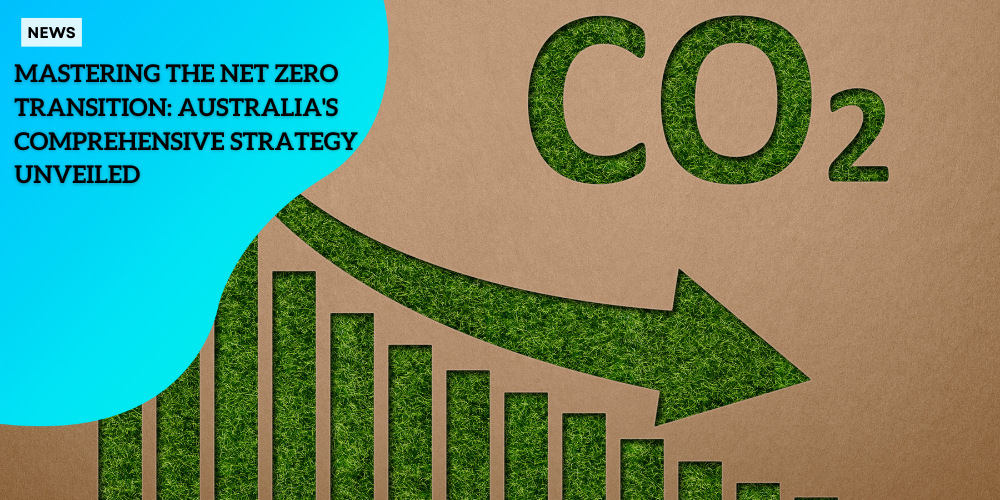Mastering the Net Zero Transition: Australia’s Comprehensive Strategy Unveiled

Anúncios
Introduction to Australia’s Net Zero Ambition
Australia is embarking on a pivotal mission to achieve net zero greenhouse gas emissions by 2050.
This ambitious objective is part of the larger global climate action aimed at keeping the planet within safe temperature limits.
Anúncios

Commitment to this goal signifies Australia’s drive to pave the way for sustainable progress and to inspire similar actions worldwide.
Anúncios
The Scale of the Transition
This shift to net zero isn’t just another policy change; it’s set to be the biggest economic transformation since the Industrial Revolution.
The Australian Government acknowledges the significant scope of this transition and the diverse facets it encompasses.
By fostering innovation and investing in new technologies, Australia aims to create a high-wage, efficient, and productive economy dominated by low emissions and renewable energy.
Targets and Commitments
Australia’s roadmap to 2050 is clear and resolute.
By 2030, the country aims to cut its greenhouse gas emissions by 42.7% compared to 2005 levels, with even stricter targets to be unveiled for 2035.
These targets are designed to ensure Australia meets its 2050 goal through structured and measurable milestones.
The comprehensive strategy outlined in the Net Zero Plan includes six critical sectors: electricity, transport, industry, agriculture, resources, and the built environment.
The integration with current initiatives like the Capacity Investment Scheme and Vehicle Efficiency Standards illustrates a coordinated plan to ensure environmental goals align harmoniously with economic growth.
The Need for a Robust Plan
Achieving net zero necessitates concerted efforts across all sectors.
The government will promote energy efficiency, implement circular economy principles, expand the renewable electricity grid, and electrify various sectors.
In addition, developing alternative fuel sources such as hydrogen and low-carbon liquid fuels are also central components of this strategy.
Moving Forward
Engaging with all relevant stakeholders—including communities, industry, investors, academia, and unions—will be essential.
The process will involve diverse consultation phases to ensure a pragmatic and widely accepted plan.
Special emphasis will be placed on including feedback from First Nations people, regional communities, and youth to ensure inclusivity and comprehensiveness in the approach.
Next, we will delve deeper into how these core components will interplay, providing a sturdy foundation for Australia’s vision of a low-carbon future.
This collaboration will shape a more detailed picture of the sector-specific strategies and how they are set to transform the nation’s economy.
Core Components of the Net Zero Plan
Australia’s Net Zero Plan envisions a transformative journey across six pivotal sectors: electricity, transport, industry, agriculture, resources, and the built environment.
Each sector is targeted to contribute significantly to the overarching goal of net zero emissions by 2050.
Let’s delve into these strategies and how they align with existing initiatives to ensure a smooth and effective transition.
| Sector | Before | After (Net Zero Strategy) |
|---|---|---|
| ⚡ Electricity and Energy | Fossil fuel-based grid | Decarbonized grid with renewable energy sources |
| 🚗 Transport | High emissions from internal combustion engine vehicles | Electrified vehicles and use of alternative fuels |
| 🏭 Industry | Energy-intensive processes with high emissions | Improved energy efficiency and low-carbon materials |
| 🌾 Agriculture and Land | High methane emissions and unsustainable land use | Sustainable land practices and enhanced soil carbon storage |
| 🌍 Resources | Fossil fuel-based extraction methods | Transition to clean energy and low-carbon mineral processing |
| 🏢 Built Environment | Energy-inefficient buildings | Energy-efficient buildings with smart technology |
Integration with Existing Initiatives
The Net Zero Plan seamlessly integrates with current initiatives, ensuring synergy across efforts.
The Capacity Investment Scheme and Vehicle Efficiency Standards form the backbone of this transition, providing a solid foundation to build upon.
These initiatives make it feasible for sectors to leverage established frameworks while exploring innovative emission reduction techniques.
Such integration is crucial for harnessing existing momentum and facilitating smoother implementation of the net zero objectives.
Balancing Environmental and Economic Goals
Achieving net zero is not only about cutting emissions but also about crafting a sustainable economy that doesn’t compromise growth.
The plan seeks to strike a balance by encouraging new industries and green job creation while ensuring current economic stability.
Through this comprehensive strategy, Australia aims to maintain its economic competitiveness internationally while setting an example of environmental leadership.
The Core Components of the Net Zero Plan lay the groundwork for a sustainable future, tying together environmental aspirations with economic vitality.
As the plan progresses, it becomes crucial to ensure stakeholder engagement and consultation to realize its full potential.
Key Decarbonization Strategies
Australia’s decarbonization goals call for a multifaceted approach involving various innovative strategies.
Central to this ambition is boosting energy efficiency and transitioning towards renewable energy sources and sustainable practices.
Increasing Energy Efficiency
One of the most impactful strategies involves ramping up energy efficiency across all sectors.
This means not only reducing the amount of energy required to perform the same tasks but also adopting circular economy principles.
Circular economy approaches, which focus on minimizing waste and continually using resources, are crucial for fostering sustainability and reducing emissions.
By improving materials efficiency and recycling, industries can significantly cut down their carbon footprint.
Transitioning to Renewable Electricity
Another cornerstone of Australia’s net zero plan is the transition to renewable electricity.
The government aims to decarbonize and expand the electricity grid by integrating more renewable energy sources like solar, wind, and hydroelectric power.
By shifting away from fossil fuels and electrifying activities wherever possible, Australia can achieve substantial emissions reductions.
This strategy is essential for enabling the decarbonization of other sectors, as a green electricity grid supports the sustainable use of electric vehicles and energy-efficient appliances.
Developing Alternative Fuel Sources
To address sectors where electrification is challenging, Australia is investing in alternative fuel sources.
Hydrogen, produced from renewable energy, and low-carbon liquid fuels are seen as vital replacements for conventional fossil fuels.
These alternatives are particularly important for heavy industries and long-distance transport, where electrification may not be feasible.
Hydrogen, for example, can be used in fuel cells for vehicles or in industrial processes, significantly cutting down carbon emissions.
Innovation and Technological Advancements
A consistent theme across all decarbonization strategies is the need for ongoing innovation.
By pushing the boundaries of low and zero-emission technologies, Australia aims to reduce costs and enhance the deployment of these solutions.
From advancements in battery storage to breakthroughs in renewable energy technologies, continuous innovation is crucial for meeting Australia’s ambitious climate goals.
Carbon Sequestration Techniques
Additionally, scaling up both nature-based and technological carbon sequestration methods is part of the comprehensive strategy.
Carbon sequestration involves capturing and storing carbon dioxide from the atmosphere, thereby reducing the overall greenhouse gas concentration.
This can be done through reforestation, soil management practices, or technological solutions like direct air capture.
These strategies are not just about cutting emissions; they’re about fostering economic growth and positioning Australia as a leader in the global green economy.
By investing in green technologies and sustainable practices, the country can create new job opportunities, stimulate industry innovation, and drive economic resilience.
Preparing for the future involves understanding the interplay between these strategies, adapting to new developments, and engaging with all stakeholders to ensure that the transition to net zero is both effective and inclusive.
As the next step, it is essential to look into the structured rollout and milestones that will guide these initiatives towards 2050.
Stakeholder Engagement and Consultation
Building a Collaborative Framework
Transitioning to net zero emissions is a monumental task that requires the input and support of all sectors of society.
Australia’s approach is deeply rooted in collaboration with key stakeholders.
This includes reaching out to communities, industry leaders, investors, academia, and unions to ensure a comprehensive and inclusive strategy.
By involving these parties early in the process, the government aims to create a robust and ambitious plan that resonates with public sentiment and leverages expert insights.
This will not only validate the approach but also build a strong foundation of trust and cooperation.
Diverse and Regular Consultations
To make sure everyone has a voice, regular consultation processes are being set up.
These include roundtables, forums, and targeted discussions.
Key groups like First Nations people, regional communities, and the youth are prioritized to guarantee their perspectives are heard and considered in shaping policies.
Such inclusivity ensures that the plan is representative of Australia’s diverse population and addresses unique regional challenges and opportunities.
Engaging First Nations and Regional Communities
A special focus is on engaging First Nations people and regional communities.
These groups possess valuable traditional knowledge and have unique perspectives on land use and sustainability that are crucial for effective climate action.
Acknowledging their input and empowering their participation can lead to more equitable and culturally sensitive outcomes.
This engagement will take the form of direct consultations, incorporating their feedback into the broader strategy.
Overall, the stakeholder engagement strategy is about building consensus and creating shared goals for a sustainable future.
This sets the stage for realizing economic opportunities while addressing upcoming challenges, moving towards a cohesive national effort that unites various sectors under a common goal.
Implementation Timeline and Milestones
Implementing Australia’s ambitious Net Zero Plan requires meticulous structuring to ensure every milestone is met with precision and vigilance.
The rollout is set to begin in 2023 and span through 2025, with specified periods dedicated to consultation, review, and revision.
Structured Rollout and Key Milestones
A detailed timeline outlines the pivotal steps in the journey towards net-zero emissions.
The following key milestones delineate the sequence of events:
- Mid-2023: Announcement of the Net Zero Planning process and initiation of Climate Change Authority (CCA) advice. 🌍
- Late 2023: Commencement of early consultation and engagement processes, including discussions on Agriculture and Land. 🌱
- March-June 2024: Main consultation and engagement activities for the entire economy and specific sectors. 💼
- March-August 2024: Intensive engagement with state and territory governments to ensure alignment and integration of efforts. 🤝
- September 2024: The CCA publishes a review detailing technological opportunities and the challenges for each sector. 📊
- 2025: The CCA offers advice on emission reduction targets for 2035. 📅
Climate Change Authority’s Role
The Climate Change Authority (CCA) plays a critical role in the timeline, providing independent and evidence-based advice to the government.
Their responsibilities include:
- Conducting comprehensive reviews of technological pathways for each sector. 🔍
- Issuing two key pieces of advice: the Sector Pathways Review (focusing on technology) and recommendations on the 2035 emission reduction targets. 📑
- Ensuring the Net Zero Plan adheres to principles of environmental effectiveness, economic efficiency, and equitable benefits for all Australians. 🌏
Regular Assessments and Adjustments
To maintain momentum and adapt to new information and trends, ongoing assessment and adjustment mechanisms are vital:
- Regular reviews: The CCA will conduct evaluations and provide updated advice as needed, ensuring the plan remains relevant and effective. 🔄
- Dynamic adjustments: Targets and strategies may be adjusted based on real-time progress, technological advances, and stakeholder feedback. ⚙️
The structured approach in these stages is critical for navigating challenges and seizing opportunities, making Australia’s path to net zero both achievable and sustainable.
This diligent planning ensures that the journey incorporates flexibility and resilience, settings Australia up to meet its climate goals successfully.
Economic Opportunities and Challenges
Creation of New Jobs and Industries
Australia’s journey to net zero offers a wealth of opportunities, laying the groundwork for new jobs and industries focused on green technologies and renewable energy.
This transformative era encourages the growth of sectors such as solar and wind energy, battery storage, and green hydrogen production.
As traditional industries pivot towards sustainable practices, employment in sectors like renewable energy, waste management, and sustainable agriculture is set to boom.
The production of low-carbon materials and the expansion of the circular economy will also lead to new business ventures and job creations.
The government’s commitment to this green transition ensures that the workforce is adaptable and skilled to meet these new demands.
Positioning Australia as a Renewable Energy Superpower
By harnessing its vast natural resources and technological prowess, Australia is positioning itself as a renewable energy superpower on the global stage.
Investments in renewable energy infrastructure, such as large-scale solar farms and offshore wind projects, are pivotal.
Additionally, Australia is becoming a key player in the export of green hydrogen and renewable electricity, providing clean energy solutions to the world.
The strategic alliances and innovations in battery storage technologies enhance Australia’s capability to offer reliable and sustainable energy globally.
This positions the nation favorably in international markets while leading in the fight against climate change.
Managing Transition Challenges
Despite the manifold opportunities, the transition to a net zero economy is rife with challenges that must be managed effectively.
A key concern is ensuring that the shift does not compromise economic competitiveness. Industries will need substantial investments and policies to facilitate a smooth transition from fossil fuels to renewable energy sources.
Training and reskilling the current workforce is another critical aspect to avoid unemployment and ensure workers can transition into new roles within emerging green industries.
Also, maintaining a balance between accelerated climate action and economic stability requires meticulous planning.
For instance, while integrating renewable energy sources, the existing energy infrastructure must be upgraded to cope with new technologies.
It is equally vital to address the social implications, making sure that regional and vulnerable communities are supported through targeted initiatives.
By carefully managing these challenges, Australia can leverage its position in the global green economy, ensuring a sustainable and prosperous future for all.
The next steps involve addressing these concerns while continuing the momentum towards a carbon-neutral economy.






